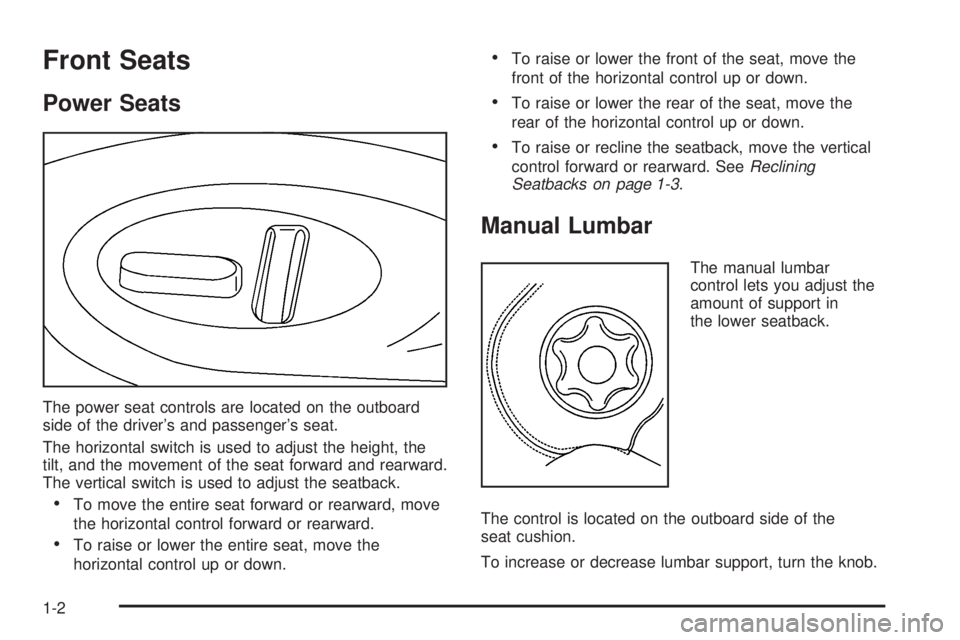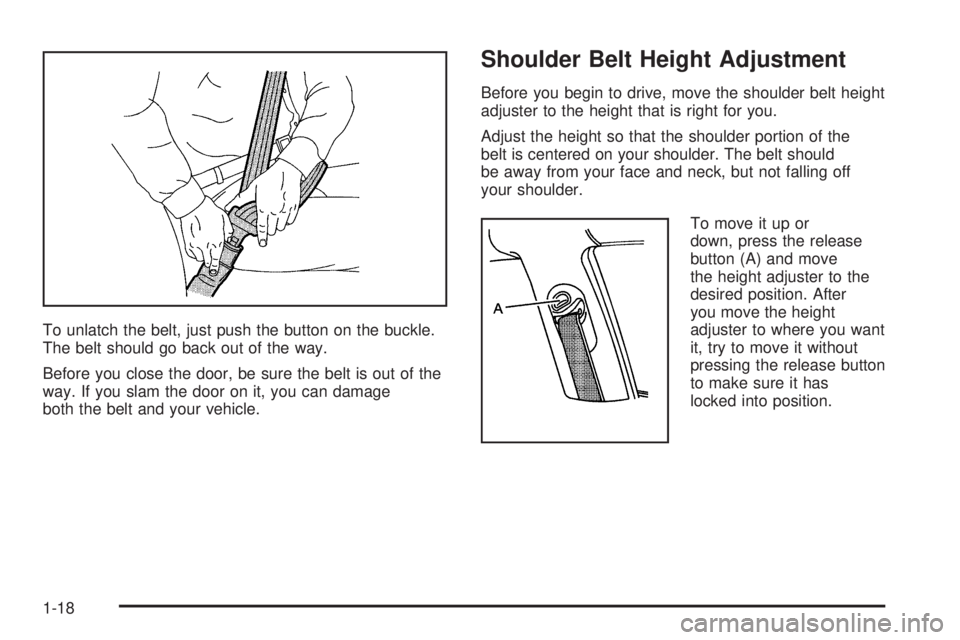2005 PONTIAC GTO height
[x] Cancel search: heightPage 7 of 318

Front Seats......................................................1-2
Power Seats..................................................1-2
Manual Lumbar..............................................1-2
Reclining Seatbacks........................................1-3
Head Restraints.............................................1-4
Seatback Latches...........................................1-4
Safety Belts.....................................................1-6
Safety Belts: They Are for Everyone.................1-6
Questions and Answers About Safety Belts......1-10
How to Wear Safety Belts Properly.................1-11
Driver Position..............................................1-12
Shoulder Belt Height Adjustment.....................1-18
Safety Belt Use During Pregnancy..................1-19
Right Front Passenger Position.......................1-19
Rear Seat Passengers..................................1-19
Rear Safety Belt Comfort Guides for
Children and Small Adults..........................1-22
Safety Belt Pretensioners...............................1-24
Child Restraints.............................................1-25
Older Children..............................................1-25
Infants and Young Children............................1-28
Child Restraint Systems.................................1-31Where to Put the Restraint.............................1-34
Top Strap....................................................1-35
Top Strap Anchor Location.............................1-36
Lower Anchorages and Top Tethers for
Children (LATCH System)...........................1-37
Securing a Child Restraint Designed for
the LATCH System....................................1-39
Securing a Child Restraint in a Rear
Seat Position............................................1-39
Securing a Child Restraint in the Right
Front Seat Position....................................1-41
Airbag System...............................................1-44
Where Are the Airbags?................................1-46
When Should an Airbag Inflate?.....................1-47
What Makes an Airbag Inflate?.......................1-48
How Does an Airbag Restrain?.......................1-48
What Will You See After an Airbag Inflates?.....1-48
Servicing Your Airbag-Equipped Vehicle...........1-50
Restraint System Check..................................1-50
Checking the Restraint Systems......................1-50
Replacing Restraint System Parts
After a Crash............................................1-51
Section 1 Seats and Restraint Systems
1-1
Page 8 of 318

Front Seats
Power Seats
The power seat controls are located on the outboard
side of the driver’s and passenger’s seat.
The horizontal switch is used to adjust the height, the
tilt, and the movement of the seat forward and rearward.
The vertical switch is used to adjust the seatback.
•To move the entire seat forward or rearward, move
the horizontal control forward or rearward.
•To raise or lower the entire seat, move the
horizontal control up or down.
•To raise or lower the front of the seat, move the
front of the horizontal control up or down.
•To raise or lower the rear of the seat, move the
rear of the horizontal control up or down.
•To raise or recline the seatback, move the vertical
control forward or rearward. SeeReclining
Seatbacks on page 1-3.
Manual Lumbar
The manual lumbar
control lets you adjust the
amount of support in
the lower seatback.
The control is located on the outboard side of the
seat cushion.
To increase or decrease lumbar support, turn the knob.
1-2
Page 18 of 318

Driver Position
Lap-Shoulder Belt
The driver has a lap-shoulder belt. Here is how to wear
it properly.
1. Close and lock the door.
2. Adjust the seat so you can sit up straight. To see
how, see “Seats” in the Index.
3. Pick up the latch plate and pull the belt across you.
Do not let it get twisted.The shoulder belt may lock if you pull the belt
across you very quickly. If this happens, let the belt
go back slightly to unlock it. Then pull the belt
across you more slowly.
4. Push the latch plate into the buckle until it clicks.
Pull up on the latch plate to make sure it is secure.
Make sure the release button on the buckle is
positioned so you would be able to unbuckle the
safety belt quickly if you ever had to.
5. Move the shoulder belt height adjuster to the height
that is right for you. SeeShoulder Belt Height
Adjustment on page 1-18.
1-12
Page 24 of 318

To unlatch the belt, just push the button on the buckle.
The belt should go back out of the way.
Before you close the door, be sure the belt is out of the
way. If you slam the door on it, you can damage
both the belt and your vehicle.
Shoulder Belt Height Adjustment
Before you begin to drive, move the shoulder belt height
adjuster to the height that is right for you.
Adjust the height so that the shoulder portion of the
belt is centered on your shoulder. The belt should
be away from your face and neck, but not falling off
your shoulder.
To move it up or
down, press the release
button (A) and move
the height adjuster to the
desired position. After
you move the height
adjuster to where you want
it, try to move it without
pressing the release button
to make sure it has
locked into position.
1-18
Page 36 of 318

Q:What are the different types of add-on child
restraints?
A:Add-on child restraints, which are purchased by the
vehicle’s owner, are available in four basic types.
Selection of a particular restraint should take
into consideration not only the child’s weight, height
and age but also whether or not the restraint will
be compatible with the motor vehicle in which it will
be used.
For most basic types of child restraints, there are
many different models available. When purchasing a
child restraint, be sure it is designed to be used
in a motor vehicle. If it is, the restraint will have a
label saying that it meets federal motor vehicle
safety standards.
The restraint manufacturer’s instructions that come
with the restraint, state the weight and height
limitations for a particular child restraint. In addition,
there are many kinds of restraints available for
children with special needs.
{CAUTION:
Newborn infants need complete support,
including support for the head and neck. This
is necessary because a newborn infant’s neck
is weak and its head weighs so much
compared with the rest of its body. In a crash,
an infant in a rear-facing seat settles into the
restraint, so the crash forces can be
distributed across the strongest part of
an infant’s body, the back and shoulders.
Infants always should be secured in
appropriate infant restraints.
1-30
Page 86 of 318

Mirrors
Manual Rearview Mirror
The mirror can be adjusted two ways. First, to adjust
the height of the mirror, adjust the arm that connects the
mirror to the windshield. Second, adjust the angle of
the mirror by moving the mirror to a position that allows
you to see out of the back window.
To reduce glare from headlamps behind you, move the
lever toward you to the night position. To return the
mirror to the daytime position, move the lever away
from you.
Outside Power Mirrors
The controls for the power
mirrors are located on the
driver’s door armrest.You can adjust the angle of the mirrors when the
ignition is on.
Move the selector switch located above the four-way
control pad to choose the right or left mirror. To adjust
a mirror, use the four-way control pad to move the
mirror in the direction that you want it to go.
Outside Convex Mirror
Your passenger’s side mirror is convex. A convex
mirror’s surface is curved so you can see more from the
driver’s seat.
{CAUTION:
A convex mirror can make things (like other
vehicles) look farther away than they really are.
If you cut too sharply into the right lane, you
could hit a vehicle on your right. Check your
inside mirror or glance over your shoulder
before changing lanes.
2-28
Page 224 of 318

Brake Wear
Your vehicle has four-wheel disc brakes.
Some driving conditions or climates may cause a brake
squeal when the brakes are first applied or lightly
applied. This does not mean something is wrong with
your brakes.
Properly torqued wheel nuts are necessary to help
prevent brake pulsation. When tires are rotated, inspect
brake pads for wear and evenly tighten wheel nuts in
the proper sequence to GM torque specifications.
Brake linings should always be replaced as complete
axle sets.
Brake Pedal Travel
See your dealer if the brake pedal does not return to
normal height, or if there is a rapid increase in
pedal travel. This could be a sign of brake trouble.
Brake Adjustment
Every time you make a moderate brake stop, your disc
brakes adjust for wear. If you rarely make a moderate
or heavier stop, then your brakes might not adjust
correctly. If you drive in that way, then — very
carefully — make a few moderate brake stops about
every 1,000 miles (1 600 km), so your brakes will
adjust properly.
Replacing Brake System Parts
The braking system on a vehicle is complex. Its many
parts have to be of top quality and work well together if
the vehicle is to have really good braking. Your
vehicle was designed and tested with top-quality
GM brake parts. When you replace parts of your braking
system — for example, when your brake linings wear
down and you need new ones put in — be sure you get
new approved GM replacement parts. If you do not,
your brakes may no longer work properly. For example,
if someone puts in brake linings that are wrong for
your vehicle, the balance between your front and rear
brakes can change — for the worse. The braking
performance you have come to expect can change in
many other ways if someone puts in the wrong
replacement brake parts.
5-38
Page 240 of 318

Tire Sidewall Labelling
Useful information about a tire is molded into its
sidewall. The examples below show a typical passenger
vehicle tire and a compact spare tire sidewall.
(A) Tire Size:The tire size is a combination of letters
and numbers used to define a particular tire’s width,
height, aspect ratio, construction type and service
description. See the “Tire Size” illustration later in this
section for more detail.(B) TPC Spec (Tire Performance Criteria
Speci�cation):Original equipment tires designed to
GM’s specific tire performance criteria have a TPC
specification code molded onto the sidewall. GM’s TPC
specifications meet or exceed all federal safety
guidelines.
(C) DOT (Department of Transportation):The
Department of Transportation (DOT) code indicates that
the tire is in compliance with the U.S. Department of
Transportation Motor Vehicle Safety Standards.
(D) Tire Identi�cation Number (TIN):The letters and
numbers following DOT (Department of Transportation)
code is the Tire Identification Number (TIN). The
TIN shows the manufacturer and plant code, tire size,
and date the tire was manufactured. The TIN is molded
onto both sides of the tire, although only one side
may have the date of manufacture.
(E) Tire Ply Material:The type of cord and number of
plies in the sidewall and under the tread.
(F) Uniform Tire Quality Grading (UTQG):Tire
manufacturers are required to grade tires based on
three performance factors: treadwear, traction and
temperature resistance. For more information see
Uniform Tire Quality Grading on page 5-64.
(G) Maximum Cold In�ation Load Limit:Maximum
load that can be carried and the maximum pressure
needed to support that load. Passenger (P-Metric) Tire Example
5-54